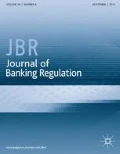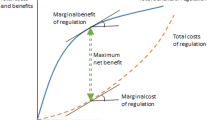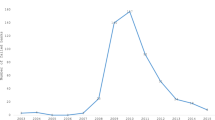Abstract
We use requirements governing external audits in the US banking industry as a case study to illustrate the complexity of regulatory structure. Complexity reflects a flexibility that has been used to “tailor” regulations for particular categories of banks. But it appears to conflict with recent proposals to “rationalize” a system that is said to lack coherence.
Similar content being viewed by others
Notes
The $1 billion threshold, established in 2005, replaced an original threshold of $500 million.
Reports are filed with FDIC regional offices. Non-confidential parts of them must be made publicly available but with limited accessibility (on-site at a bank).
References
Volcker Alliance. 2015. Reshaping the Financial Regulatory System.
U.S. Treasury. 2017. A Financial System that Creates Economic Opportunities.
Economic Growth and Regulatory Paperwork Reduction Act. 2015. Hearings in Boston.
Economic Growth and Regulatory Paperwork Reduction Act. 2017. Federal Register (March 30).
U.S. Senate Committee on Banking, Housing and Urban Affairs. 2017. Senators Release Text of “Economic Growth, Regulatory Relief and Consumer Protection Act” (November 16).
U.S. Treasury. 2017. A Financial System that Creates Economic Opportunities.
Economic Growth and Regulatory Paperwork Reduction Act. 2017. Federal Register (March 30).
U.S. Treasury. 2017. A Financial System that Creates Economic Opportunities.
Awrey, D. 2011. Regulating financial innovation: A more principles-based approach? Brooklyn Journal of Corporate, Financial & Commercial Law 5: 273–315.
Lautenschlager, S. 2017. Walled Off? Banking regulation after the crisis. Bank for International Settlements (March 13).
Cunningham, L. 2007. A prescription to retire the rhetoric of “principles-based systems” in corporate law, securities regulation and accounting. Vanderbilt Law Review 60: 1409–1494.
U.S. General Accounting Office (GAO). 1989. Bank Failures: Independent Audits Needed to Strengthen Internal Control and Bank Management.
Ibid.
Ibid, Appendix VI.
Bies, S. 2002. Effective accounting and disclosure for financial transactions and financial institutions. BIS Review 63: 1–5.
Broughton, K. 2017. What’s behind the curious rise in bank auditing woes? American Banker (March 9).
Altamuro, J., and A. Beatty. 2010. How does internal control regulation affect financial reporting. Journal of Accounting and Economics 49: 58–74.
Dahl, D., J. O’Keefe, and G. Hanweck. 1998. The influence of examiners and auditors on loan-loss recognition. FDIC Banking Review 11: 10–25.
Jin, J., K. Kanagaretnam, and G. Lobo. 2013. Unintended consequences of the increased asset threshold for FDICIA internal controls: Evidence from U.S. private banks. Journal of Banking & Finance 37: 4879–4892.
Jin, J., K. Kanagaretnam, G. Lobo, and R. Mathieu. 2013. Impact of FDICIA internal controlson bank risk taking. Journal of Banking & Finance 37: 614–624.
LaFond, R., and H. You. 2010. The federal deposit insurance corporation improvement act, bank internal controls and financial reporting quality. Journal of Accounting and Economics 49: 75–83.
Independent Community Bankers of America. 2016. Comments Regarding Amendments to Smaller Reporting Company Definition (August 29).
Economic Growth and Regulatory Paperwork Reduction Act. 2017. Federal Register (March 30).
Ibid.
Awrey, D. 2011. Regulating financial innovation: A more principles-based approach? Brooklyn Journal of Corporate, Financial & Commercial Law 5: 273–315.
FDIC. 2005. 12 C.F.R. Part 363, Final Rule, November 28, 2005 (Part 363).
Independent Community Bankers of America. 2016. Comments Regarding Amendments to Smaller Reporting Company Definition (August 29).
Awrey, D. 2011. Regulating financial innovation: A more principles-based approach? Brooklyn Journal of Corporate, Financial & Commercial Law 5: 273–315.
FDIC. 2005. 12 C.F.R. Part 363, Final Rule, November 28, 2005 (Part 363).
Economic Growth and Regulatory Paperwork Reduction Act. 2017. Federal Register (March 30).
Lautenschlager, S. 2017. Walled Off? Banking regulation after the crisis. Bank for International Settlements (March 13).
Economic Growth and Regulatory Paperwork Reduction Act. 2015. Hearings in Boston.
Acknowledgements
The views expressed are those of the individual authors and do not reflect official positions of the Federal Reserve Bank of St. Louis, the Federal Reserve System, or the Board of Governors.
Author information
Authors and Affiliations
Corresponding author
Rights and permissions
About this article
Cite this article
Dahl, D., Sherrer, L. The complexity of bank regulation: audit requirements in the USA. J Bank Regul 20, 286–289 (2019). https://doi.org/10.1057/s41261-018-0091-2
Published:
Issue Date:
DOI: https://doi.org/10.1057/s41261-018-0091-2




